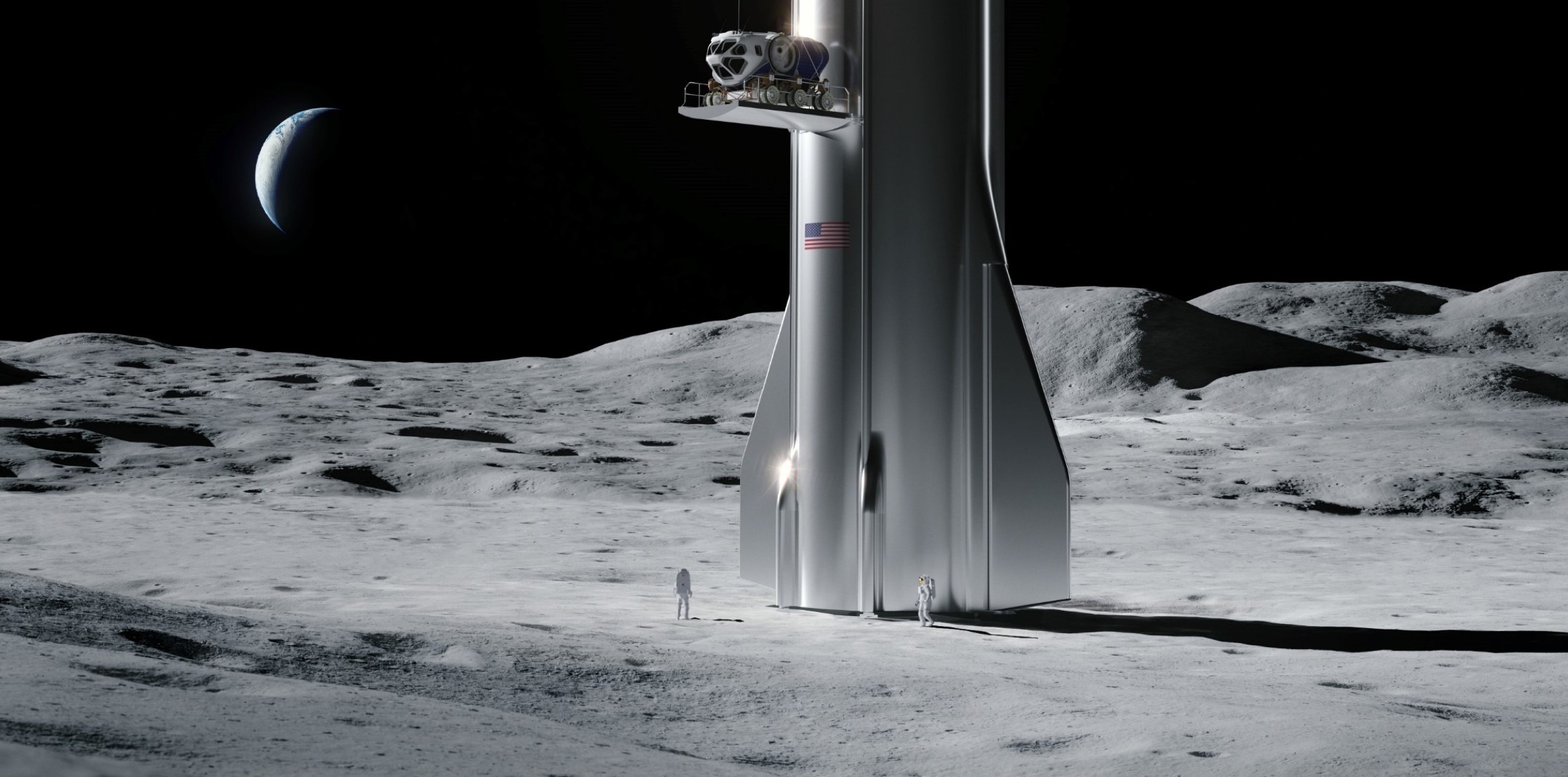
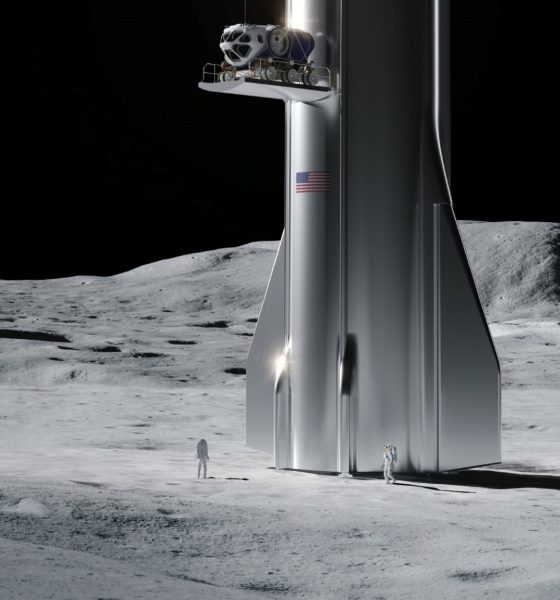
News
SpaceX’s Starship to spar with Blue Origin for NASA Moon landing contracts
On November 18th, NASA announced that it had added commercial Moon lander offerings from SpaceX, Blue Origin, Sierra Nevada Corporation, and others to a pool of companies that will be able to compete to affordably deliver cargo to the surface of the Moon. With this latest addition of landers, competition could get very interesting, very quickly.
In November 2018, NASA revealed a big step forward in its plans to kickstart robotic exploration and utilization of the Moon, announcing nine new partners in its Commercial Lunar Payload Services (CLPS) initiative. Designed first and foremost to encourage the commercial development of unprecedentedly affordable Moon landers, the program’s first nine partners included Lockheed Martin, Astrobotic, Intuitive Machines, Masten Space, Orbit Beyond, and several others.
In May 2019, NASA announced the next step, contracting with three of those nine aforementioned providers to bring their proposed Moon landers to fruition and attempt their first lunar landings. Orbit Beyond dropped out shortly after but Astrobotic and Intuitive Machines continue to work towards that goal and aim to attempt the first Moon landings with their respective Peregrine and Nova-C spacecraft no earlier than (NET) July 2021. Intuitive Machines has contracted a SpaceX Falcon 9 for its first Nova-C Moon launch, while Astrobotic side with the very first launch of United Launch Alliance’s (ULA) next-generation Vulcan rocket.

Generally speaking, the landers offered by the first nine CLPS partners were on the smaller side of the spectrum, capable of delivering around 50-100 kg (100-200 lb) of useful cargo to the surface of the Moon with launch masses around 1500-3000 kg (3300-6600 lb). On November 18th, NASA announced that a second group of partners would be added to the competitive ‘pool’ of CLPS-eligible Moon landers, all of which can technically compete to land a range of NASA payloads on the Moon. The new five are Ceres Robotics, Tyvak Nano-Satellite Systems, Sierra Nevada Corporation, Blue Origin, and SpaceX.
Next to nothing is known about Tyvak’s or Ceres Robotics’ apparently proposed landers, but a render of SNC’s Moon lander concept shares some obvious similarities with its Dream Chaser spacecraft and expendable power and propulsion module, implying that it’s likely on the larger side. Blue Origin and SpaceX, of course, proposed their Blue Moon and Starship spacecraft.
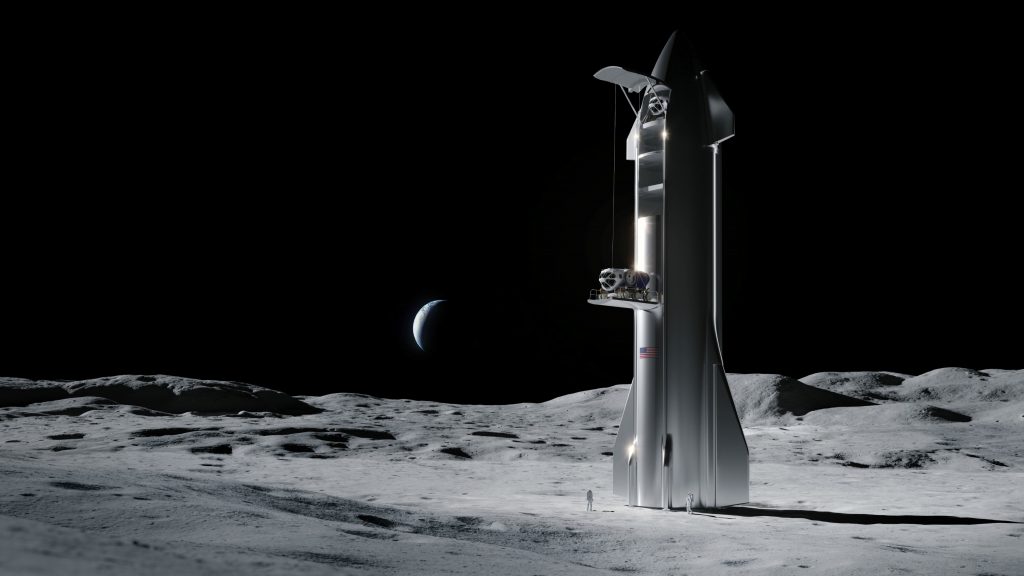
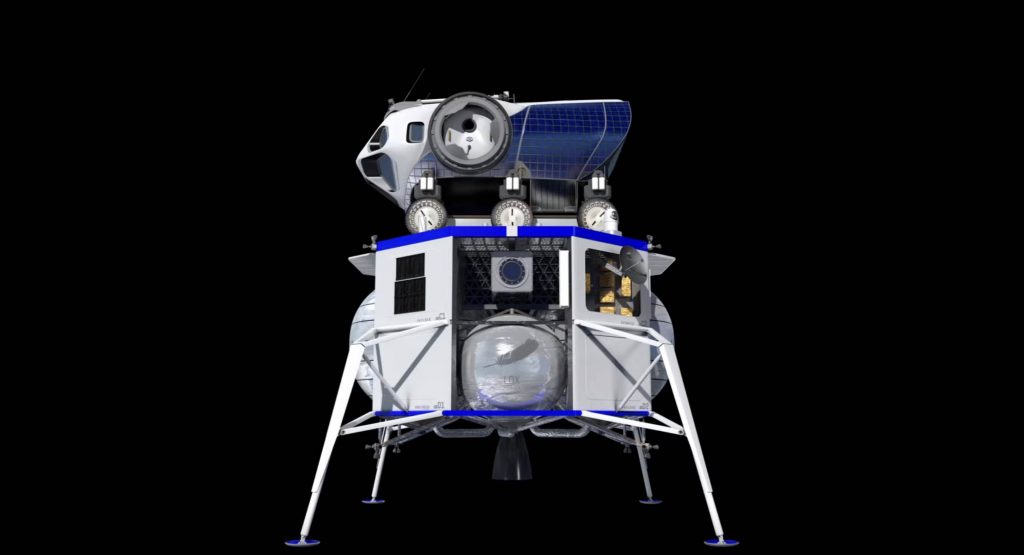
As a 100%-speculative guess, Ceres and Tyvak’s landers are likely in the same ~100 kg-class range as the nine CLPS providers selected before it, while Sierra Nevada’s lander concept is probably closer to 500 kg (1100 lb). According to Blue Origin, it’s recently-updated Blue Moon lander is designed to deliver up to 4500 kg (9900 lb) to the lunar surface and is expected to attempt its first Moon landing no earlier than 2024.
Unsurprisingly, SpaceX’s Starship blows all 13 other lander proposals out of the water and, in the context of the CLPS program, is a bit like bringing a Gatling gun to a paintball match. According to SpaceX, a fully-refueled Starship should be able to land 100 metric tons (220,000 lb) of cargo on the Moon, although it’s unclear if that would allow the Starship to return to Earth.
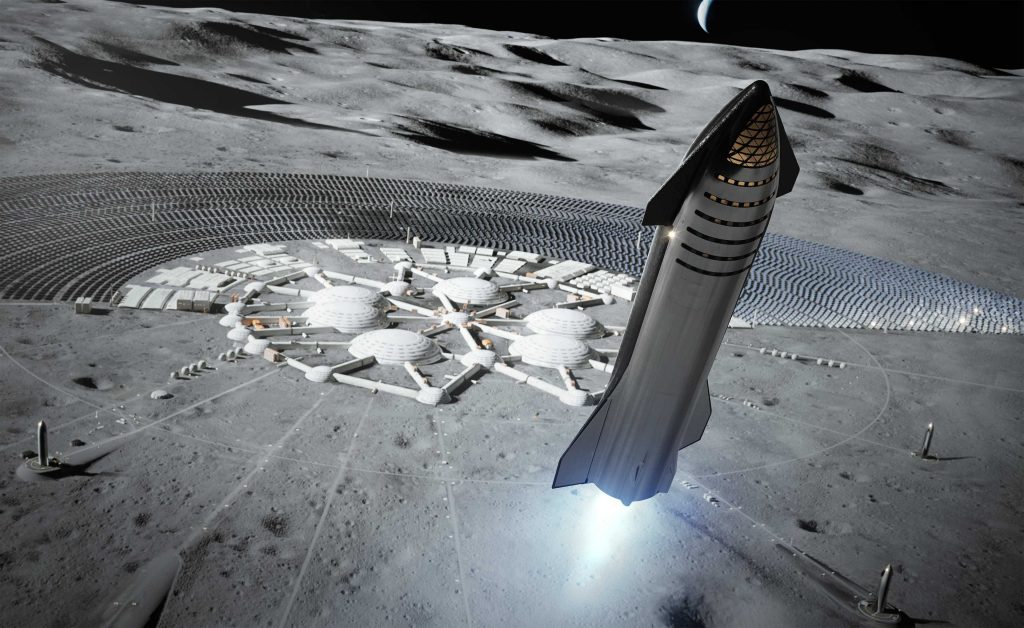
In simpler terms, there is just no chance whatsoever that the practical scope of NASA’s CLPS program could possibly warrant more than a few metric tons delivered to the surface of the Moon. NASA as a whole doesn’t have the budget needed to build useful several-dozen-ton spacecraft or experiments, let alone CLPS. In that sense, the real question to ask is what could Starship manage if the useful payloads it needs to deliver are no more than a few metric tons?
Assuming SpaceX’s technical know-how is mature enough to allow Starship to preserve cryogenic propellant for weeks or months after launch, it’s entirely conceivable that a Moon launch with, say, 10 tons of cargo could be achieved with just one or two in-orbit refuelings, all while leaving that Starship enough margin to safely return to Earth. Given that NASA awarded Intuitive Machines and Astrobotic approximately $80M apiece to land 50-100 kg on the Moon, it’s far too easy to imagine SpaceX quoting a similar price to deliver 10+ tons to the Moon by enabling full Starship reuse.
All things considered, politics still looms in the distance and there is just as much of a chance that SpaceX (and maybe even Blue Origin) will be passed over by CLPS when the time comes to award the next round of Moon delivery contracts. Still, the odds of something far out of the ordinary happening are much higher with a program like CLPS. Stay tuned!
Check out Teslarati’s Marketplace! We offer Tesla accessories, including for the Tesla Cybertruck and Tesla Model 3.

News
Elon Musk’s Grokipedia surges to 5.6M articles, almost 79% of English Wikipedia
The explosive growth marks a major milestone for the AI-powered online encyclopedia, which was launched by Elon Musk’s xAI just months ago.

Elon Musk’s Grokipedia has grown to an impressive 5,615,201 articles as of today, closing in on 79% of the English Wikipedia’s current total of 7,119,376 articles.
The explosive growth marks a major milestone for the AI-powered online encyclopedia, which was launched by Elon Musk’s xAI just months ago. Needless to say, it would only be a matter of time before Grokipedia exceeds English Wikipedia in sheer volume.
Grokipedia’s rapid growth
xAI’s vision for Grokipedia emphasizes neutrality, while Grok’s reasoning capabilities allow for fast drafting and fact-checking. When Elon Musk announced the initiative in late September 2025, he noted that Grokipedia would be an improvement to Wikipedia because it would be designed to avoid bias.
At the time, Musk noted that Grokipedia “is a necessary step towards the xAI goal of understanding the Universe.”
Grokipedia was launched in late October, and while xAI was careful to list it only as Version 0.1 at the time, the online encyclopedia immediately earned praise. Wikipedia co-founder Larry Sanger highlighted the project’s innovative approach, noting how it leverages AI to fill knowledge gaps and enable rapid updates. Netizens also observed how Grokipedia tends to present articles in a more objective manner compared to Wikipedia, which is edited by humans.
Elon Musk’s ambitious plans
With 5,615,201 total articles, Grokipedia has now grown to almost 79% of English Wikipedia’s article base. This is incredibly quick, though Grokipedia remains text-only for now. xAI, for its part, has now updated the online encyclopedia’s iteration to v0.2.
Elon Musk has shared bold ideas for Grokipedia, including sending a record of the entire knowledge base to space as part of xAI’s mission to preserve and expand human understanding. At some point, Musk stated that Grokipedia will be renamed to Encyclopedia Galactica, and it will be sent to the cosmos.
“When Grokipedia is good enough (long way to go), we will change the name to Encyclopedia Galactica. It will be an open source distillation of all knowledge, including audio, images and video. Join xAI to help build the sci-fi version of the Library of Alexandria!” Musk wrote, adding in a later post that “Copies will be etched in stone and sent to the Moon, Mars and beyond. This time, it will not be lost.”
News
Tesla Model 3 becomes Netherlands’ best-selling used EV in 2025
More than one in ten second-hand electric cars sold in the country last year was a Tesla Model 3.

The Tesla Model 3 became the most popular used electric car in the Netherlands in 2025, cementing its dominance well beyond the country’s new-car market.
After years at the top of Dutch EV sales charts, the Model 3 now leads the country’s second-hand EV market by a wide margin, as record used-car purchases pushed electric vehicles further into the mainstream.
Model 3 takes a commanding lead
The Netherlands recorded more than 2.1 million used car sales last year, the highest level on record. Of those, roughly 4.8%, or about 102,000 vehicles, were electric. Within that growing segment, the Tesla Model 3 stood far ahead of its competitors.
In 2025 alone, 11,338 used Model 3s changed hands, giving the car an 11.1% share of the country’s entire used EV market. That means more than one in ten second-hand electric cars sold in the country last year was a Tesla Model 3, Auto Week Netherlands reported. The scale of its lead is striking: the gap between the Model 3 and the second-place finisher, the Volkswagen ID3, is more than 6,700 vehicles.
Rivals trail as residual values shape rankings
The Volkswagen ID.3 ranked a distant second, with 4,595 used units sold and a 4.5% market share. Close behind was the Audi e-tron, which placed third with 4,236 registrations. As noted by Auto Week Netherlands, relatively low residual values likely boosted the e-tron’s appeal in the used market, despite its higher original price.
Other strong performers included the Kia Niro, the Tesla Model Y, and the Hyundai Kona, highlighting continued demand for compact and midsize electric vehicles with proven range and reliability. No other model, however, came close to matching the Model 3’s scale or market presence.
News
Tesla Model Y Standard Long Range RWD launches in Europe
The update was announced by Tesla Europe & Middle East in a post on its official social media account on X.

Tesla has expanded the Model Y lineup in Europe with the introduction of the Standard Long Range RWD variant, which offers an impressive 657 km of WLTP range.
The update was announced by Tesla Europe & Middle East in a post on its official social media account on X.
Model Y Standard Long Range RWD Details
Tesla Europe & Middle East highlighted some of the Model Y Standard Long Range RWD’s most notable specs, from its 657 km of WLTP range to its 2,118 liters of cargo volume. More importantly, Tesla also noted that the newly released variant only consumes 12.7 kWh per 100 km, making it the most efficient Model Y to date.
The Model Y Standard provides a lower entry point for consumers who wish to enter the Tesla ecosystem at the lowest possible price. While the Model 3 Standard is still more affordable, some consumers might prefer the Model Y Standard due to its larger size and crossover form factor. The fact that the Model Y Standard is equipped with Tesla’s AI4 computer also makes it ready for FSD’s eventual rollout to the region.
Top Gear’s Model Y Standard review
Top Gear‘s recent review of the Tesla Model Y Standard highlighted some of the vehicle’s most notable features, such as its impressive real-world range, stellar infotainment system, and spacious interior. As per the publication, the Model Y Standard still retains a lot of what makes Tesla’s vehicles well-rounded, even if it’s been equipped with a simplified interior.
Top Gear compared the Model Y Standard to its rivals in the same segment. “The introduction of the Standard trim brings the Model Y in line with the entry price of most of its closest competition. In fact, it’s actually cheaper than a Peugeot e-3008 and costs £5k less than an entry-level Audi Q4 e-tron. It also makes the Ford Mustang Mach-E look a little short with its higher entry price and worse range,” the publication wrote.








